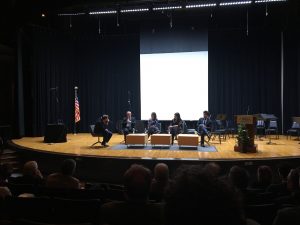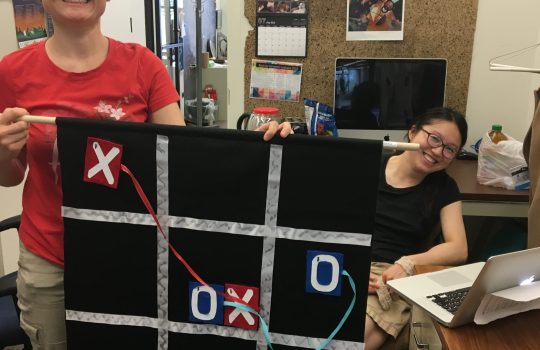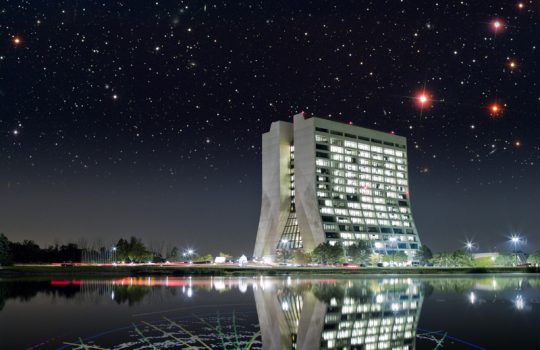
John Pletz moderates a panel for IMSA’s 30th anniversary. From left: John Pletz, Nigel Lockyer, Jessica Droste Yagan, Claudia Flores, Steve Chen. Photo: Dan Garisto
The Illinois Mathematics and Science Academy celebrated its 30th anniversary March 30 with a ribbon-cutting ceremony and a panel on STEM education featuring Fermilab Director Nigel Lockyer.
IMSA was originally conceived in 1982 by Fermilab’s second director, Leon Lederman, on the principle that advancing STEM education was vital to scientific and societal progress. With the help of then-Illinois Governor Jim Thompson, IMSA was established in 1985 and opened to students the next year. As a public residential college prep academy, IMSA students come from across the state to live on its campus in Aurora and learn through a rigorous curriculum.
The school’s anniversary theme, “Think.Different.Act.Bold,” owes much to Lederman.
“Creativity is the thing we want to foster the most. We’re not terribly interested in IQs or phenomenal memories,” Lederman said in a 1990 interview about IMSA.
At the ceremony, IMSA president Jose Torres acknowledged this mission, affirming his faith that IMSA students and alumni would work creatively to change society for the better, addressing problems such as those outlined in the United Nations Millennium Development Goals.
At IMSA, hands-on learning, including a research collaboration with over 70 leading institutions and entrepreneurship programs, takes center stage.
Tech journalist John Pletz moderated the panel on STEM education, which in addition to Lockyer also included three notable IMSA alumni: YouTube co-founder Steve Chen, International Human Rights Clinic Director Claudia Flores, and Impact Engine CEO Jessica Droste Yagan. In a wide-ranging discussion, the panel talked about diverse topics such as the importance of community to science and apps for buying groceries.
Chen, who funded a new center for innovation at IMSA, attributed his success to the freedom he had at IMSA to explore his interest in computer programming. Flores spoke about the power of being around passionate and differently skilled people.
Highlighting IMSA’s connection to Fermilab, Lockyer said, “We want more students from IMSA at Fermilab. We’ve had hundreds over the years. It always brings in outside-the-box creativity.”
Demonstrating just that kind of creativity, IMSA students used virtual-reality technology to simulate the ribbon-cutting, manipulating virtual scissors to cut virtual ribbon to release virtual balloons — all displayed for the audience on a projected screen.
Every year, dozens of IMSA students do research at Fermilab. Pranav Sivakumar, a senior at IMSA who works with Fermilab physicist Brian Nord, was named a finalist in the Google Science Fair for his research on quasar lensing.
IMSA gives its students Wednesdays off to pursue extracurricular activities. Like many students, Sivakumar uses his time to pursue research, coming to Fermilab every week to work on quasars.
This symbiotic relationship between Fermilab and places like IMSA is key to both of their success, according to Pletz.
“National labs understand need for talent, which places like this are designed to find and grow and nurture,” he said.



